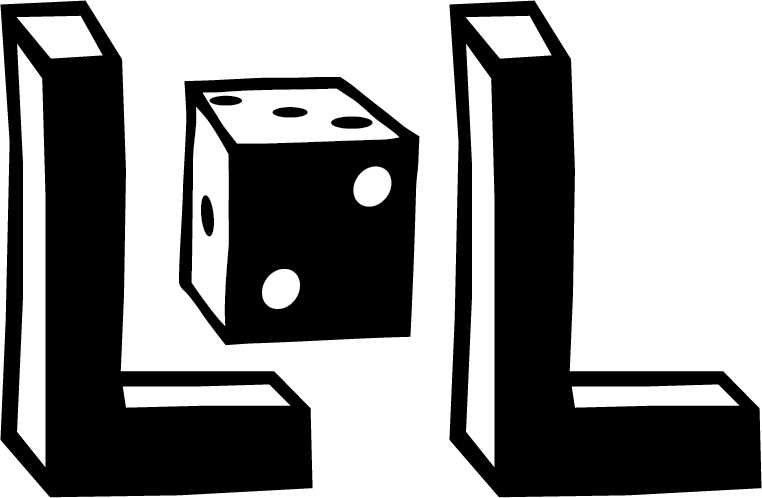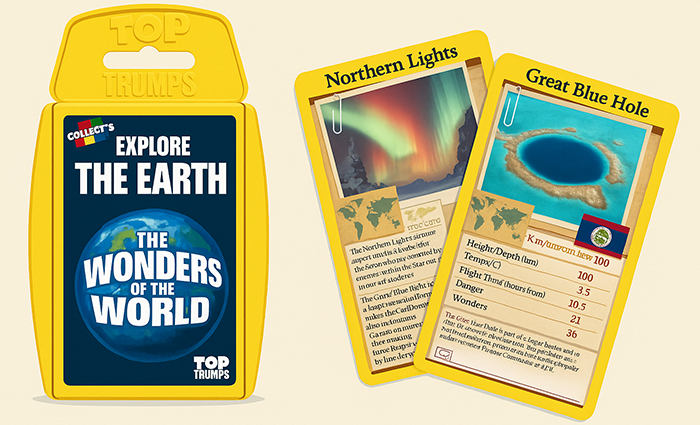Top Trumps is a classic competitive card game where each card represents a specific element (cars, animals, superheroes, monuments, etc.) accompanied by various numerical statistics. The game mechanism is simple: players compare the numerical values of their cards to determine who wins each round. The characteristic that makes this game particularly suitable for language teaching is the constant need to read, compare, and comment on numerical data, naturally stimulating the use of comparative and superlative structures.
Different games with Top Trumps mechanics exist, such as Top Trump Battle Mat or Mini Match. In this article, I focus on the game with classic rules because it’s more suitable for a foreign language class.
Another interesting version to use in class is Top Trump Quiz. For example, in English there’s the “Countries and Flags” game with 500 geographical, historical, and cultural questions, which combines the card mechanism with quiz elements, offering additional opportunities for language practice and knowledge expansion.
Many thematic versions of Top Trumps exist: from sports cars to wild animals, from world monuments to historical figures, allowing the game to be adapted to any curriculum or student interest.
In an educational context, it can be used to reinforce comparative structures, practice numbers and units of measurement, expand specialised vocabulary, and develop argumentative skills.
Adaptation to the educational context:
The game is useful for foreign language teaching because of:
Intensive practice of comparatives – Every game turn necessarily requires the use of comparative structures (“taller than,” “less fast than,” “the biggest”), making this grammatical practice natural and motivated by the playful context.
Acquisition of specialized numerical vocabulary – Students must correctly read and pronounce complex numbers, units of measurement, percentages, and statistics, developing essential skills for scientific and professional communication.
Learning specialized vocabulary in context – Each thematic deck introduces a specific lexical field (automotive, zoological, geographical) that is assimilated through repeated and meaningful use during the game.
Language practice:
Vocabulary: Specialized vocabulary of the chosen theme, numerals, units of measurement, descriptive adjectives
Grammar: Comparatives and superlatives, comparison structures (“while,” “instead,” “unlike”), quantity expressions
Conversation: Argumentation of strategic choices, discussion of data, expression of surprise or disappointment
Storytelling: Description of element characteristics, creation of narrative contexts
Tips for adapting the game to the class level and lesson needs:
– For more advanced levels, require comments on results using expressions of surprise (“I didn’t expect that…,” “It’s incredible that…”).
– Modify traditional rules by allowing group discussions before revealing values, encouraging collaborative negotiation and argumentation.
– After each turn, compare all card statistics. Ask students to vote for the best one (e.g., if playing with world countries, choose which country they would like to visit) and explain their choice.
– Use the game as a warm-up by introducing only 5-6 cards per session, focusing on the quality of linguistic interaction rather than game duration.
– Integrate follow-up activities where students create their own Top Trumps cards on curricular topics, thus developing research and synthesis skills.
Examples of use in CLIL and other subjects:
1. Learn to use numerical data and statistics in the foreign language
2. Acquire automatisms in using comparative structures essential for scientific communication
3. Develop argumentative and problem-solving strategies in an authentic linguistic context
4. Consolidate disciplinary knowledge through systematic comparison of information
The game mechanics are particularly well-suited to subjects where it’s important to develop comparative and analytical skills through quantitative data.
Geography
Use decks with world countries, cities, mountains, rivers, or monuments. Statistics can include altitude, population, surface area, average temperatures.
For monuments, compare height, year of construction, annual number of visitors, simultaneously developing cultural knowledge and comparative skills.
Natural Sciences
Animal decks allow comparison of weight, speed, life expectancy, habitat. Students practice not only comparatives but also scientific vocabulary: “The cheetah is faster than the lion, but the lion is heavier than the cheetah.”
For plants, compare height, longevity, geographical distribution, developing botanical knowledge and descriptive skills.
History
Create cards with historical figures, comparing birth and death years, reign duration, number of battles won, etc. Students develop comparative chronologies: “Napoleon lived longer than Alexander the Great, but ruled for less time.”
Alternatives include historical events with duration, number of participants, measurable consequences.
Chemistry
Chemical elements with atomic number, atomic weight, melting point. Students compare properties while assimilating scientific terminology: “Iron has a higher melting point than lead.”
Literature
Create cards with famous writers comparing birth and death years, number of published works, foreign language translations, literary prizes won. Students develop literary chronologies: “Shakespeare lived less than Goethe, but his works have been translated into more languages.”
An interesting alternative is comparing works by a single author: number of pages, publication year, sales, film adaptations.
Economics
Countries or companies with GDP, population, growth rate. Students work with percentages, graphs, and economic trends, developing mathematical skills and specialized vocabulary of the economic world.
Online resources
On the Top Trumps website you can discover all game versions.

